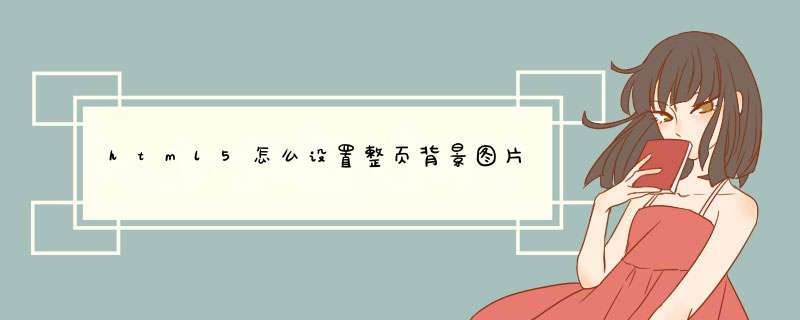
html5中设置整页背景图片的方法是利用css3样式:
写法如下:
img.bg {
/* Set rules to fill background */
min-height: 100%
min-width: 1024px
/* Set up proportionate scaling */
width: 100%
height: auto
/* Set up positioning */
position: fixed
top: 0
left: 0
}
@media screen and (max-width: 1024px) { /* Specific to this particular image */
img.bg {
left: 50%
margin-left: -512px /* 50% */
}
}
效果如:
步骤 1: 在 HTML 中设置画布,创建一个引用,并获取上下文对象
画布在 HTML 中通过 <canvas>标签定义。与其他标签类似,<canvas>的属性(如宽度和高度)作为特性输入。假设你希望创建一个宽 500 像素、高 500 像素的画布,并将其命名为“can1”,稍后在 JavaScript 中引用它时将用到。
在 HTML 文档中输入 <canvas>标签。
<canvas id="can1" width="500" height="500"></canvas>在 JavaScript 文档中,创建一个变量,在编写脚本时该变量将代替“can1”。这里,我们将该变量命名为“myCanvas”,并使用 getElementById 将其链接到“can1”。
var myCanvas = document.getElementById("can1")画布的 CanvasRenderingContext2D 对象具有 *** 作画布的所有命令。 这里,在上下文对象中检索“can1”。将此变量称为“myContext”。
var myContext = myCanvas.getContext("2d")步骤 2: 绘制矩形、直线、贝塞尔曲线、圆和形状
在画布上绘制简单的线条非常容易。使用 JavaScript 的 moveTo 方法可设置线条开始位置的坐标。然后只需使用另一方法设置终点。 第二步可以使用若干方法,每种方法专用于帮助呈现一种不同的线型,无论是直线、贝塞尔曲线还是圆弧。若要将线条合并为形状,可以闭合对 beginPath 和 closePath 方法调用中的线条。在指定所需的外观之后,可以使用 fill 方法应用颜色,并使用 stroke 方法执行线条和形状的呈现。
应用一些基本风格。这里,通过使用 fillStyle 属性绘制一个黑色矩形,将画布背景设置为黑色 (#000)。然后使用 strokeStyle 属性将线条颜色设置为白色 (#fff),使用 fillRect 方法应用黑色背景,并使用 lineWidth 属性将线条的粗细设置为 3 个像素。
// Specify a black background, and white lines that are 3 pixels thick.
myContext.fillStyle = '#000'
myContext.strokeStyle = '#fff'
myContext.fillRect(0,0,500,500)
myContext.lineWidth = 3myContext.fill()
在后续步骤中,将在这个 500×500 的黑色画布上继续构建。
现在,准备在画布的黑色表面绘制一个白色线条。先从直线开始。
使用 moveTo 方法设置直线的起点,使用 lineTo 方法设置终点。
这些方法采用两个数字作为参数。第一个数字表示 x 轴坐标,或者表示此坐标定义的自画布左侧算起的像素数。第二个数字是从顶部开始测量的 y 轴坐标。
// Draw a line that starts at the upper left corner of the canvas and ends at the lower right.
myContext.moveTo(0,0)
myContext.lineTo(500,500)
myContext.stroke()
若要绘制二次贝塞尔曲线,请使用 quadraticCurveTo 方法,该方法采用两个坐标—曲线的一个控制点和一个端点。
// Draw a swooping curve that spans the width of the canvas.myContext.moveTo(0,0)
myContext.quadraticCurveTo(0,500,500,250)
myContext.stroke()
若要绘制三次贝塞尔曲线,请使用 bezierCurveTo 方法,该方法采用三个坐标—曲线的两个控制点和一个端点。
// Draw a V-shaped Bezier curve that spans the entire canvas.myContext.moveTo(0,0)
myContext.bezierCurveTo(500, 820, 0, 500, 500, 0)
myContext.stroke()
若要创建一个圆,请使用 arc 方法:在设置用于绘制圆形轮廓的原点时,请确保将 moveTo 方法设置在沿线条路径的位置上,否则圆上将有一条通向 moveTo坐标的“尾巴”。
// Draw a circle that spans the width of the canvas.myContext.moveTo(500,250)
myContext.arc(250,250,250,0,Math.PI*2,true)
myContext.stroke()
通过闭合对 beginPath 和 closePath 调用中的多个线条,可以从上述线条的任意组合中绘制一个 2D 形状。然后,整个形状可以使用 fill 接收一种颜色。前面设置的笔划样式将创建白色线条,在与应用于主体的红色 (#f00) 合并时,该形状将继承双色调外观。
// Draw a red diamond that spans the entire canvas.myContext.fillStyle = '#f00'
myContext.beginPath()
myContext.moveTo(250,0)
myContext.lineTo(0,250)
myContext.lineTo(250,500)
myContext.lineTo(500,250)
myContext.closePath()
myContext.fill()
步骤 3: 显示位图图像
位图图像(如 .jpg、.png 和 .gif 文件)可以放置在画布上,甚至可以在代码中缩放和裁剪,不会触及原始文件。若要添加位图图像,请指定该图像的 URI,然后使用 drawImage 方法在画布上指定其位置。使用可选参数可将图像缩放到指定的大小,甚至仅显示图像的一个片段,这对于实现滚动背景或使用子画面表动态显示子画面等 *** 作非常有用。
若要在屏幕上绘制位图图像而不进行任何修改,请指定要用于左上角的 x 坐标和 y 坐标。
// Draw an image at the upper left corner of the canvas (0, 0).var myImg = new Image()
myImg.src = 'myImageFile.png'
myContext.drawImage(myImg, 0, 0)
若要缩放图像,可在末尾添加两个数字,分别代表宽度和高度。如果有帮助,不妨将后两个数字视为“右部”和“底部”,而不是“宽度”和“高度”。
// Scale the image to span the entire 500 x 500 canvas.var myImg = new Image()
myImg.src = 'myImageFile.png'
myContext.drawImage(myImg, 0, 0, 500, 500)
若要仅使用图像的一个切片,则需要定义两个矩形区域,对 drawImage 的调用提高到 9 个参数(第一个参数是 JavaScript 图像对象)。要传入的前四个数字表示图像的切片。后四个数字表示要显示该切片的画布区域。
// Take a 20 x 20 slice from the upper left of the image and scale it to span the entire 500 x 500 canvas.var myImg = new Image()
myImg.src = 'myImageFile.png'
myContext.drawImage(myImg, 0, 0, 20, 20, 0, 0, 500, 500)
步骤 4: 渐变
任何人只要熟悉在图形设计程序中定义渐变的常见方式,都会喜欢使用 JavaScript 代码定义渐变的简单性。在设计程序中是选择颜色,渐变中的颜色位置使用水平滑块设置。JavaScript 中的唯一区别是使用从 0 到 1 范围内的小数值代替滑块。
在设计程序中,线性渐变使用线条在图像上定位,线条的开始和结束位置确定方向和缩放级别。在 JavaScript 中,该线条使用两对 x、y 轴坐标绘制。然后将 4 个数字传递到 createLinearGradient 方法以创建 CanvasGradient 对象。在定义渐变对象的属性之后,就会得到所需的渐变,CanvasGradient 作为 fillStyle 传递到 fillRect 方法进行呈现。
// Render a white, red and black gradient diagonally across the canvas.var myGradient = myContext.createLinearGradient(0,0, 500,500) // gradient starts at upper left and ends at lower right
myGradient.addColorStop(0,"#fff") // white at the beginning of the gradient
myGradient.addColorStop(0.5,"#f00")// red in the middle of the gradient
myGradient.addColorStop(1,"#000") // black at the end of the gradient
myContext.fillStyle = myGradient // ensure the next call to fillRect will use the specified gradient
myContext.fillRect(0,0,500,500) // rectangle that contains the gradient spans the entire canvas
径向渐变的定义方式稍有不同。为渐变的起点和终点绘制两对 x、y 轴坐标—,这与线性渐变中一样—,但每个坐标对都有第三个与其关联的 z 轴坐标,用于定义半径。可以想像为围绕一个坐标绘制一个圆,该坐标位于中心 (250, 250),绘制的圆的大小以像素为单位定义。这样定义两个圆之后,一个圆较小,一个圆跨整个画布,有 6 个数字传递到 createRadialGradient。在呈现时,径向渐变在两个圆之间的空间中绘制,颜色等级与圆的半径的大小成正比。
// Render a white, red and black radial gradient spanning the canvas.var myGradient = myContext.createRadialGradient(250,250,0, 250,250,500) // gradient is centered and spans the entire canvas
myGradient.addColorStop(0,"#fff") // white at the beginning of the gradient
myGradient.addColorStop(0.5,"#f00") // red in the middle of the gradient
myGradient.addColorStop(1,"#000") // black at the end of the gradient
myContext.fillStyle = myGradient // ensure the next call to fillRect will use the specified gradient
myContext.fillRect(0,0,500,500) // rectangle that contains the gradient spans the entire canvas
步骤 5: 动画
可以使用多种方法绘制动画。
对于画布内的元素,JavaScript 提供了 setInterval 方法,该方法计划一个重复调用的函数,每经过定义的时间间隔便调用一次该函数。在该函数中,需要重绘画布来反映对其上呈现的对象的更改。下面是一个示例,其中一个函数初始化该动画,将呈现频率计划为大约每秒 60 帧(每 13.33 毫秒一帧),并且重复调用该函数将重绘画布。在本例中,径向渐变从一个小点逐渐增大,直到填充整个画布。
// Generate an animation of a growing gradient.// These variables must exist globally so both functions can access them.
var myCanvas
var myContext
var outerBoundary = 0, innerBoundary = 0
// Start the animation.
window.onload = initialize
function initialize() {
myCanvas = document.getElementById("can1")
myContext = myCanvas.getContext("2d")
setInterval("redrawCanvas()",13) // redraw @ approximately 60 frames per second
}
// Run the animation.
function redrawCanvas() {
if (outerBoundary < 500) {
outerBoundary++ // grow the size of the gradient
} else {
innerBoundary++ // grow the size of the inner white circle if red is maxed
}
var myGradient = myContext.createRadialGradient(250,250,innerBoundary, 250,250,outerBoundary)
myGradient.addColorStop(0,"#fff") // white at the beginning of the gradient
myGradient.addColorStop(0.5,"#f00") // red in the middle of the gradient
myGradient.addColorStop(1,"#000") // black at the end of the gradient
myContext.fillStyle = myGradient // ensure the next call to fillRect will use the specified gradient
myContext.fillRect(0,0,500,500) // rectangle that contains the gradient spans the entire canvas
}
CSS3 转换和动画可用于转换画布本身和画布外部的对象。
此外,新的 WinJS 库有许多高度优化的动画,创建这些动画是为了模拟原有 Windows 动画的行为。 WinJS 动画有助于为你的应用 UI 提供一个高度集成的外观。有关详细信息,请参阅WinJS.UI.Animation 命名空间。
步骤 6: 更多 HTML5 画布提示
可以使用一系列属性(shadowColor、shadowBlur、shadowOffsetX 和 shadowOffsetY)应用阴影。
可以使用 createPattern 方法作为一种模式重复画布中的元素。
可以使用 save 方法保存画布状态,然后执行更改,再使用 restore 方法还原以前的状态。该方法很好用,函数甚至不需要采用参数。
可以使用 globalCompositeOperation 属性定义两个画布元素重叠时会发生什么情况。 使用此属性始终可以定义在源或新元素级别发生的情况。可以执行的 *** 作有颜色混合、遮蔽和更改重叠优先级等。
注意 globalCompositeOperation 主题使用源表示新元素,使用目标表示以前存在的元素。
可以使用 strokeText 方法将文本添加到画布。
欢迎分享,转载请注明来源:内存溢出

 微信扫一扫
微信扫一扫
 支付宝扫一扫
支付宝扫一扫
评论列表(0条)